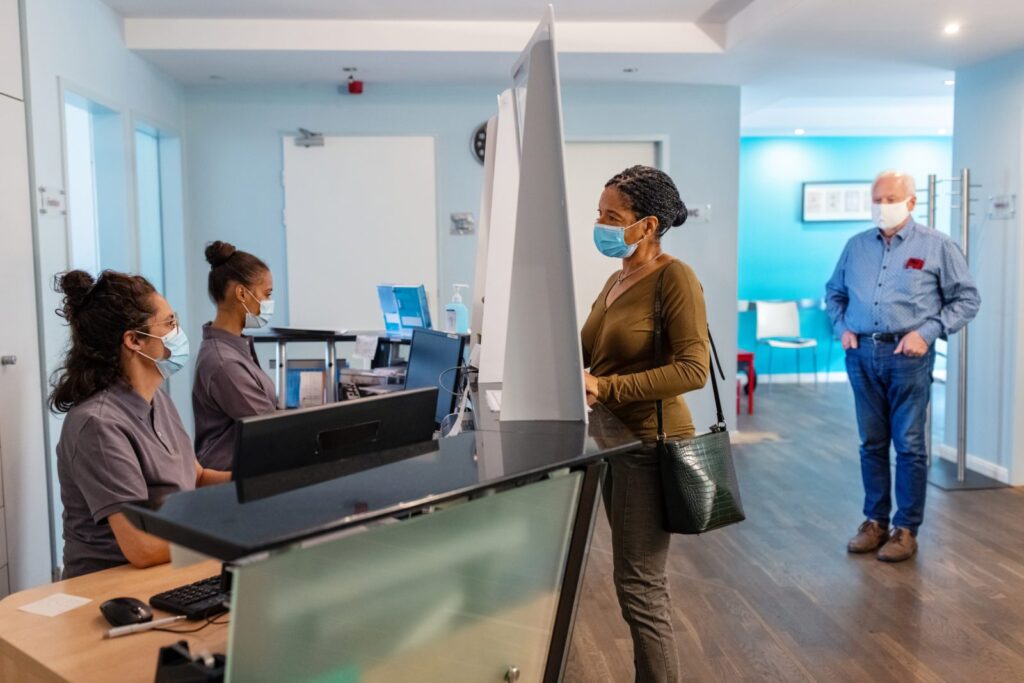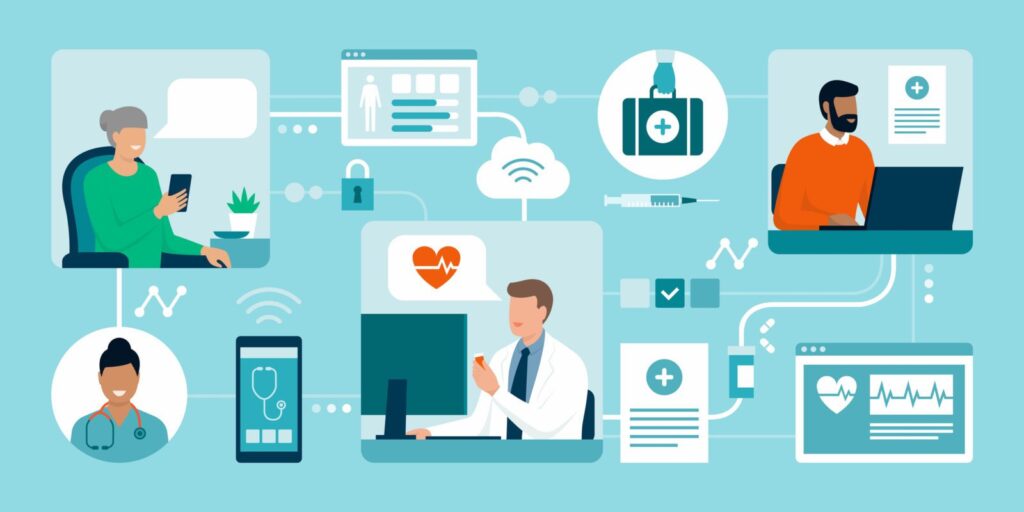
Social distancing is great. Medical distancing? Not so much. Doctor visits are still necessary for ensuring good health.
By Jane Sarasohn-Kahn, MA, MHSA
Welcome to the era of medical distancing in America.
Since the second quarter of 2020, consumers have become well-acquainted with the concept of “physical distancing”—i.e., standing six feet from another human being at the grocery store, pharmacy or post office queue. This suggestion was just one piece of advice that the CDC gave as a way to avoid exposure to the COVID-19 virus from another person.
But medical distancing is a term you may not have heard—but you’ve probably seen firsthand (or even done yourself). Medical distancing refers to patients who avoid or delay seeking care that they would have previously sought by going to a physician’s office or emergency department.
“We worked so hard to get people to stay socially distanced that we have created a perception that it is not only unsafe to go out, but it’s unsafe to go to a physician’s office or a hospital,” said Dr. Reginald Blaber, chief clinical officer at New Jersey-based Virtua Health, in an interview with the Philadelphia Business Journal.
In fact, early on in the pandemic, Virtua Health warned patients about the risks of medical distancing. The health system was especially concerned about patients dealing with chronic conditions and others experiencing acute cardiac and neurological symptoms.
“If you have hypertension or diabetes or heart disease, you can’t afford to have a ‘wait-and-see’ attitude,” explained Dr. Samuel Weiner, a primary care physician with Virtua Health.
A clinical team from the University of California – San Diego (UCSD) described their experience in providing patient care and education at UCSD like “walking a tightrope—a life or death balancing act.”
Medical Distancing Persists
IQVIA estimated that in 2020, nearly 1 billion diagnosis visits did not happen, equal to a 30% drop. These were most commonly in oncology, gastroenterology, dermatology, anesthesiology and ophthalmology. By July 2021, IQVIA projected a 207 million diagnosis visit gap.
The implications of these avoided clinical encounters would be worsened conditions for people managing chronic diseases, and delayed diagnoses of patients with advancing acute conditions and worse prognoses. IQVIA also recognized that millions of these visits would have also resulted in prescriptions for medicines that may not have ever been filled for chronic disease management, potentially exacerbating those conditions.
But medical distancing persists two years into the pandemic.
CoverMyMeds published its annual medication access report in February 2022, addressing patients’ access barriers for care and medicines as of September 2021. More than 8 in 10 patients had to delay or forgo in-person healthcare visits, most notably for primary care (66%) and specialist visits (54%). Sixteen percent had missed preventative screenings, during which diseases and conditions can be “caught at in earlier stages,” the report asserted.
The Impact on Cancer Care
Cancer care has been especially impacted by medical distancing, according to research published in February 2022 from the American Association for Cancer Research (AACR) assessing the impact of COVID-19 on cancer research and patient care.
“COVID-19 has interrupted all aspects of the cancer research and care continuum,” AACR observed. “Certain patients with cancer … are at a significantly higher risk of COVID-19 infection and severe disease” largely due to weakened immune systems, the report called out.
The pandemic caused serious interruptions across the cancer care continuum, including lessened preventive measures, reduced access to healthcare systems, and sharp declines in cancer screenings. The report also warned of the pandemic’s negative impacts on cancer health disparities, exacerbated by delayed care and screening avoidance.
In addition, COVID-19 interrupted the conduct of cancer clinical trials, which on the upside prompted the greater use of telemedicine, home delivery of trial medications, remote consenting, and collaborations with local clinics and labs.
Still, as of February 2022, “cancer screenings have yet to return to pre-pandemic levels, contributing to a likely increase in more advanced cancer diagnoses in the years ahead,” the AACR team soberly forecasted.
A Rise in Medical Distancing Among Older Adults
Many older adults in America are also choosing to medically distance themselves. A February 2022 National Poll on Healthy Aging from the University of Michigan found that 1 in 3 people over the age of 50 who had a scheduled procedure, primary care visit, or dental appointment in 2021 had a delay related to the pandemic. However, many haven’t yet returned to their provider—especially unvaccinated individuals. The differences are stark, the research discovered:
- 64% of vaccinated patients over 50 whose care was disrupted rescheduled appointments as of January 2022
- 85% of vaccinated and boosted patients had reschedule medical appointments
- Only 30% to 53% of unvaccinated patients over 50 had rescheduled their disrupted care (The percentage range depending on the type of appointment—procedure, primary care, or dental.)
“They had the appointments on their calendars, for weeks or months, to see their doctor or dentist, or to have an operation, procedure or medical test. But the pandemic disrupted those plans for around 30% of older adults with a scheduled appointment for each of these kinds of health care,” the report revealed. Lingering effects of pandemic-related disruptions to regular healthcare “could have lasting implications for older adults’ health,” the researchers warned.
Impact on Medical Practices and Their Finances
Medical distancing has had a negative impact on medical practices and their finances. A December 2020 report from the Medical Group Management Association (MGMA) and Humana had the apt subtitle, “No Time to Waste,” pointing to the importance of getting patients back into clinicians’ schedules and workflows ASAP.
Two years into the pandemic, with the problem persisting, the MGMA perspective is that the challenges of medical distancing are combining with several other forces negatively impacting physician practices in 2022: financially, longer time in accounts receivable; staffing shortages and more staff shifting to remote work; and 71% of medical practices noting that their levels of “disruptive patients” increased in 2021.
The MGMA’s advice to deal with pandemic stress in the doctor’s office can also benefit the patient side of the relationship. These tactics include leading with empathy and sharing the positive—acts of kindness and obstacles that have been overcome, for example.
As the UCSD team wrote in their essay on walking the medical distancing tightrope, “Just as the pandemic has highlighted the importance of ‘essential workers’ in society, we hope it refocuses medical care on patient-oriented service.”
That refocusing could help to close the many kinds of distance—social, medical, and emotional—between provider and patient.
A Joint Effort to Combat Medical Distancing
As a response to medical distancing, a group of healthcare industry stakeholders came together to convene the Stop Medical Distancing coalition. To illustrate the wide-ranging impact of medical distancing across the healthcare ecosystem, founding partners in the effort included the American Heart Association, Baptist Health South Florida, Children’s Hospital of Philadelphia, Baylor Scott & White Health, HealthMart Pharmacy, Humana, Kindred Healthcare, Labcorp, McKesson, Providence Health System, and Walgreens, and others have joined the effort since its inception.
The project’s message is,
“Keep social distancing.
Stop medical distancing.
It’s time to start talking to your doctor again.
Do avoid crowds.
Don’t avoid check-ups.”
In addition to promoting the steps providers have taken to keep patients safe when visiting doctor’s offices and emergency departments, the group also adds that “telemedicine is available” to help patients receive care virtually.



About The Author: Jane Sarasohn-Kahn, MA, MHSA
Through the lens of a health economist, Jane defines health broadly, working with organizations at the intersection of consumers, technology, health and healthcare. For over two decades, Jane has advised every industry that touches health including providers, payers, technology, pharmaceutical and life science, consumer goods, food, foundations and public sector.
More posts by Jane Sarasohn-Kahn, MA, MHSA